OHV Types
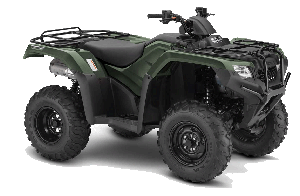 All-Terrain Vehicle (ATV): A motorized off-highway vehicle designed to travel on four low pressure tires, having a seat designed to be straddled by the operator and handlebars for steering control. ATVs are subdivided into two types as designated by the manufacturer. Type I – A Type I ATV is intended for use by a single operator and no passenger. Type II – A Type II ATV is intended for use by an operator or an operator and a passenger. It is equipped with a designated seating position behind the operator designed to be straddled by no more than one passenger.
All-Terrain Vehicle (ATV): A motorized off-highway vehicle designed to travel on four low pressure tires, having a seat designed to be straddled by the operator and handlebars for steering control. ATVs are subdivided into two types as designated by the manufacturer. Type I – A Type I ATV is intended for use by a single operator and no passenger. Type II – A Type II ATV is intended for use by an operator or an operator and a passenger. It is equipped with a designated seating position behind the operator designed to be straddled by no more than one passenger.
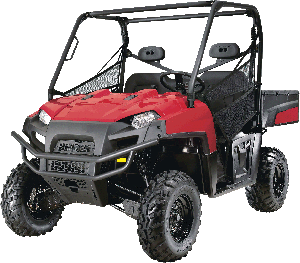 Recreational Off-Highway Vehicle (ROV): A motorized off-highway vehicle designed to travel on four or more tires, intended by the manufacturer for recreational use by one or more persons and having the following characteristics:
Recreational Off-Highway Vehicle (ROV): A motorized off-highway vehicle designed to travel on four or more tires, intended by the manufacturer for recreational use by one or more persons and having the following characteristics:
- A steering wheel for steering control
- Foot controls for throttle and service brake
- Non-straddle seating
- Maximum speed capability greater than 30 MPH (48 km/h)
- Gross Vehicle Weight Rating (GVWR) no greater than 1,700 kg (3,750 lbs)
- Less than 2,030 mm (80 in) in overall width, exclusive of accessories
- Engine displacement equal to or less than 1,000cc (61cubic in) for gasoline-fueled engines
- Identification by means of a 17 character PIN or VIN.
 Multipurpose Off-Highway Utility Vehicles (MOHUVs) more commonly termed Utility Terrain Vehicles (UTVs) are defined as vehicles having features specifically intended for utility use and having the following characteristics:
Multipurpose Off-Highway Utility Vehicles (MOHUVs) more commonly termed Utility Terrain Vehicles (UTVs) are defined as vehicles having features specifically intended for utility use and having the following characteristics:
- intended to transport a person(s) and/or cargo, with a top speed in excess of 25 mph (40.2 km/h);
- 2030 mm (80 in) or less in overall width (exclusive of accessories and attachments);
- designed to travel on four or more wheels;
- using a steering wheel for steering control;
- with a non-straddle seat;
- with a Gross Vehicle Weight Rating of no more than 1814 kg (4000 lb), and
- with a minimum cargo capacity of 159 kg (350 lb).
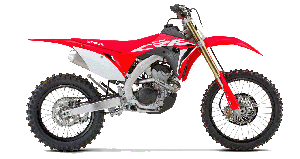 Off-Highway Motorcycles (OHMs) or Dirt Bikes are generally defined as a 2-wheeled motor vehicle that is straddled by the operator, is equipped with handlebars and that is designed for use off-highway. Dual-purpose motorcycles have off-road capability and are street-legal.
Off-Highway Motorcycles (OHMs) or Dirt Bikes are generally defined as a 2-wheeled motor vehicle that is straddled by the operator, is equipped with handlebars and that is designed for use off-highway. Dual-purpose motorcycles have off-road capability and are street-legal.
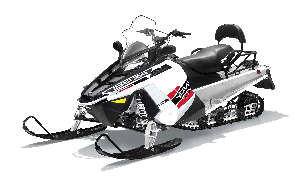 Snowmobile: A self-propelled vehicle intended for off-road travel primarily on snow,
having a curb weight of not more than 453.59 kg (1,000 lb.); driven by track or tracks in contact with the snow; and steered by a ski or skis in contact with the snow.
Snowmobile: A self-propelled vehicle intended for off-road travel primarily on snow,
having a curb weight of not more than 453.59 kg (1,000 lb.); driven by track or tracks in contact with the snow; and steered by a ski or skis in contact with the snow.
A snowmobile may be classified under the following special classes:
Class I, Competitive: A snowmobile intended solely for use in organized public racing. Racing snowmobiles are snowmobiles advertised and sold by the manufacturer for use on race courses only and not for use on trails.
Class II, Children: A snowmobile intended for daylight use, in restricted off-road areas, primarily on snow. This vehicle is intended to be used by a child at least 6 years of age, under adult supervision.
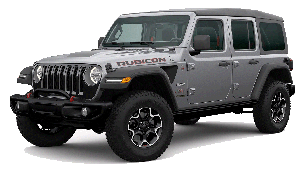 4X4s — are typically full-sized vehicles equipped for off-highway use with features that include four-wheel drive, larger tires, higher ground clearance, and configurable drive-train. Other features may include winches and specialized suspension components. These vehicles may or may not be street-legal. ATVSC also includes vehicles known as Dune Buggies, Rock Crawlers and SUVs in this category.
4X4s — are typically full-sized vehicles equipped for off-highway use with features that include four-wheel drive, larger tires, higher ground clearance, and configurable drive-train. Other features may include winches and specialized suspension components. These vehicles may or may not be street-legal. ATVSC also includes vehicles known as Dune Buggies, Rock Crawlers and SUVs in this category.